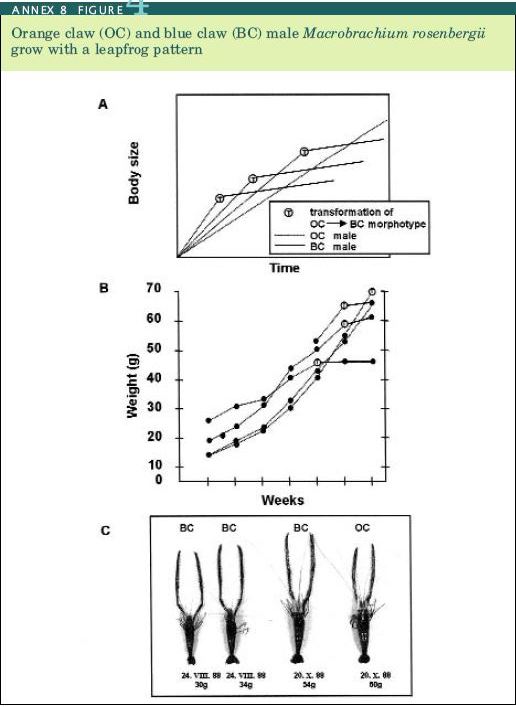4. Managing grow-out in the light of heterogeneous individual growth (HIG)
Several important characteristics of freshwater prawns that affect the potential harvest from grow-out have been described above. These create various management options; a check-list of those procedures is provided below. The first three techniques have been described in the main text of this manual. The final technique (monosex culture) is a pos sible future development and is not part of the current manual. In grow-out management:
there is an opportunity to improve the final harvest, both in terms of average market size and total production, by grading, because the prawns that are going to grow fastest become identifiable within 2-5 weeks after the PL metamorphose from larvae.
there is an opportunity to increase the final harvest, both in terms of average mar ket size and total production, by cull-harvesting. This removes the BC males, many of the OC males, and the larger females, thus encouraging small males to grow faster in the absence of dominant males (sometimes known as compensatory growth).
there are opportunities for increasing productivity through the use of substrates. These provide refuges for newly moulted prawns (which increases survival) and
ANNEX 8 FIGURE4
Orange claw (OC) and blue claw (BC) male Macrobrachium rosenbergii grow with a leapfrog pattern

SOURCE: REPRODUCED WITH PERMISSION FROM BLACKWELL SCIENCE FROM KARPLUS, SAGI AND MALECHA (2000), WHERE THE ORIGINAL SOURCES OF THE THREE ILLUSTRATIONS ARE CITED
decrease the frequency of fighting (which reduces growth suppression). This results in fewer SM, more OC and BC males, and higher average harvest weights.
the potential advantages of monosex culture, not only because of the differential growth rates of males and females but also because there is less HIG in females than in males, may eventually become exploitable.
Further reading on the experimental results of following these management options is provided in the review by Karplus, Malecha and Sagi (2000).